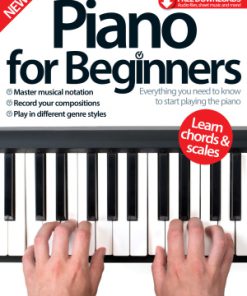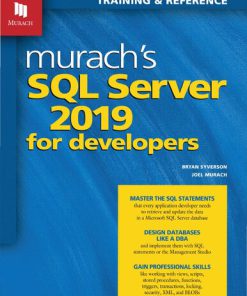UX for Beginners 1st Edition Joel Marsh 1491912642 9781491912645
$50.00 Original price was: $50.00.$25.00Current price is: $25.00.
This completed downloadable of UX for Beginners 1st Edition Joel Marsh

Instant downloaded UX for Beginners 1st Edition Joel Marsh pdf docx epub after payment.
Product details:
- ISBN 10: 1491912642
- ISBN 13: 9781491912645
- Author: Joel Marsh
Apps! Websites! Rubber Ducks! Naked Ninjas! This book has everything. If you want to get started in user experience design (UX), you’ve come to the right place: 100 self-contained lessons that cover the whole spectrum of fundamentals. Forget dry, technical material. This bookâ??based on the wildly popular UX Crash Course from Joel Marshâ??s blog The Hipper Elementâ??is laced with the author’s snarky brand of humor, and teaches UX in a simple, practical way. Becoming a professional doesnâ??t have to be boring. Follow the real-life UX process from start-to-finish and apply the skills as you learn, or refresh your memory before the next meeting. UX for Beginners is perfect for non-designers who want to become designers, managers who teach UX, and programmers, salespeople, or marketers who want to learn more. Start from scratch: the fundamentals of UX Research the weird and wonderful things users do The process and science of making anything user-friendly Use size, color, and layout to help and influence users Plan and create wireframes Make your designs feel engaging and persuasive Measure how your design works in the real world Find out what a UX designer does all day
Table of contents:
I. Key Ideas
1. What Is UX?
“Doing” UX
2. The Five Main Ingredients of UX
3. Your Perspective
Know Thyself
Empathy: Want What They Want
You Know Too Much
4. The Three “Whats” of User Perspective
“What Is This?”
“What’s in It for Me?”
“What Do I Do?”
5. Solutions versus Ideas
6. The Pyramid of UX Impact
II. Before You Start
7. User Goals and Business Goals
User Goals
Business Goals
Align the goals
8. UX Is a Process
UX Is Not an Event or a Task
A Company Has a Process, Too
Always Question the Process
9. Gathering Requirements
Requirements Protect You from Mistakes
Don’t Ask Stakeholders for Solutions or Wishes
10. Building Consensus
Know Your Craft
DO NOT LIE ABOUT UX. EVER.
III. Behavior Basics
11. Psychology versus Culture
Psychology
Culture
The Practical Difference
12. What Is User Psychology?
Why Do We Need User Psychology?
13. What Is An Experience?
14. Conscious vs Subconscious Experience
Conscious Experience
Subconscious Experience
15. Emotions
Gain and Loss
Emotions Are Reactions, Not Goals
Time Makes Emotions More Complicated
16. What Are Motivations?
The 14 Universal Motivations
Avoid death
Avoid pain
Air/water/food
Homeostasis
Sleep
Sex
Love
Protection of Children
Affiliation
Status
Justice
Understanding (Curiosity)
17. Motivation: Sex and Love
Sex Is About Reproduction
Think of sexual “rules of engagement” like an auction
Love
18. Motivation: Affiliation
Affiliation
19. Motivation: Status
Status
20. Motivation: Justice
Justice
HOMEWORK!!!!!1!!!
21. Motivation: Understanding (Curiosity)
How to Screw It Up
IV. User Research
22. What Is User Research?
Different People Will Say That User Research Happens at Different Stages in the Process
Subjective Research
Objective Research
Sample Size
Lots of subjective opinions can become… almost objective?! WTF
23. What Isn’t User Research?
You Are Not Testing the Users; They Are Testing You
Users Are Not a Crystal Ball
Don’t ask users how they want their problems solved
Consensus Is Not a UX Strategy
24. How Many Users Do You Need?
The Less Obvious the Problem, the More People You Need to Find It
Get Users Who Fit the Profile and A Couple Who Don’t
25. How to Ask Questions
Three Basic Types of Questions
Important
26. How to Observe a User
Remember: Your Memory Sucks
Read Between the Lines
Watch How They Choose, Not Just What They Choose
Do Not Help
True Story: People Will Lie to Get Your Approval
27. Interviews
What Is an Interview?
Interviews are good because…
Interviews are bad because…
You should do interviews when…
28. Surveys
What Is a Survey?
Surveys are good because…
Surveys are bad because…
You should use surveys when…
29. Card Sorting
What Is Card Sorting?
Card sorting is good because…
Card sorting is bad because…
Use card sorting when…
30. Creating User Profiles
What a Profile Is Not
So, What Is a User Profile/Persona?
Bad profile
Why it’s bad
Useful profile
Why it’s useful
Think of “Ideal” Users; Several of Them!
31. Devices
V. The Limits of Our Minds
32. What Is Intuition?
As a UX Designer, Gut Feelings Can Be Your Worst Enemy
A UX Designer’s Job Is to Design for Other People’s Gut Feelings
33. What Is a Cognitive Bias?
34. The Illusion of Choice
35. Attention
What Are You Sacrificing to Get Attention?
36. Memory
Memory Is Really Cool
All Memories Are Not Created Equal
Emphasize with Bias
Research and Memory
Beware of False Memory
37. Hyperbolic Discounting
Motivations versus Time
Usability Is a Two-Way Street
VI. Information Architecture
38. What Is Information Architecture?
Deep or Flat, Not Both
39. User Stories
40. Types of Information Architecture
41. Static and Dynamic Pages
What Is a Static Page?
What Is a Dynamic Page?
Things versus Containers
Create No-Fail Scenarios
42. What Is a Flow?
Don’t Count Clicks or Pages
Avoid Making a “Dead End”
43. Users Don’t Go Backward
User Motivation Is Rare, Not Common
Users Only Go Backward When Confused or Lost—That’s Bad
Make Loops If You Want Users to Go Backward
VII. Designing Behavior
44. Designing with Intention
UX Design Is Not a Matter of Opinion
45. Rewards and Punishments
Feelings, Not Things
Feedback to Yourself
Learning = Associations = Beliefs
46. Conditioning and Addiction
“The First Taste Is Free”
Types of conditioning
Type of rewards and punishments
Shape Their Behavior
Timing Matters
Make It Addictive
47. Gamification
What Is a Feedback Loop?
Loop it
Progressive Challenges
Game Mechanics Are Motivations and Emotions
48. Social/Viral Structure
Virality Is Much More Than Sharing: It’s a Feature
The Basic Formula
Why Does This Work?
49. How to Create Trust
Trust Is a Critical Element in Everything You Do
50. How Experience Changes Experience
Power Users Are the Minority
Hidden versus Visible: The Paradox of Choice
Recognition versus Memory
Learning Is Slow; Habits Are Fast
VIII. Visual Design Principles
51. Visual Weight (Contrast and Size)
Contrast
Depth and Size
52. Color
Meaning
Recede or Advance
Keep Wireframes Simple
Combine Visual Principles
53. Repetition and Pattern-Breaking
Breaking a Pattern
Combine Your Principles
54. Line Tension and Edge Tension
Line Tension
Edge Tension
Combine Your Principles
55. Alignment and Proximity
Alignment
Proximity
56. Using Motion for UX
If Motion Makes People Wait, It’s Bad
Motion Is Noticed First
Straight lines point in a direction
Curved lines make people follow the curve
IX. Wireframes and Prototypes
57. What Is a Wireframe?
58. What Isn’t a Wireframe?
59. Learn Skills, Not Tools
Different Tools Work in Different Situations
Design the Best Solution, Not the Solution the Tool Can Design
60. Avoid Convenient Examples
How Short Can It Be?
How Long Can It Be?
What If It Doesn’t Exist?
What If Someone Deletes It?
What’s the Worst That Can Happen?
61. What Is a Design Pattern?
62. Z-Pattern, F-Pattern, Visual Hierarchy
The Z-Pattern
F-Pattern
Why Is This Important?
Create a Visual Hierarchy
63. Layout: Page Framework
Footers
Navigation
Huge Submenus Are Never a Good Idea
tl;dr
64. Layout: The Fold, Images, and Headlines
The Fold
Images
Headlines
tl;dr
65. Layout: The Axis of Interaction
Find the Edges
66. Forms
One Long Page or a Few Short Pages?
Input Types
Labels and Instructions
Preventing and Handling Mistakes
Speed versus Mistakes
67. Primary and Secondary Buttons
Primary Buttons
Secondary Buttons
Importance Is a BIG Exception
Special Buttons
68. Adaptive and Responsive Design
Adaptive Design Is Really Just a Couple of Different Designs
Responsive Design Is One Design That Fits All Screens
69. To Design or Redesign?
Define the Problem First
Make the Smallest Change You Can Make
Sometimes the Best Redesign Is Less
70. Touch versus Mouse
A Mouse Has Some Advantages Over a Finger
Your Finger Has Some Advantages Over a Mouse
X. Psychology of Usability
71. What Is Usability, Really?
Usability = Cognitive Load
Don’t Ignore Beauty!
72. Simple, Easy, Fast, or Minimal
Simpler: Fewer Steps
Easier: More Obvious Steps
Faster: Less Time to Complete/Repeat the Process
Minimal: Fewer Functions
A Mix of Strategies Is Usually Best
73. Browsing, Searching, or Discovery
Browsing
Searching
Discovery
“If you liked that, you’re gonna love this…”
74. Consistency and Expectations
Patterns Require Consistency
Consistency Is a Tool, Not a Rule
75. Anti-UX
The Good, The Bad, and The Anti
Good UX
Bad UX
The problem
Anti-UX
Dirty UX Tricks Hurt Us All
76. Accessibility
Accessibility Is Visual
Accessibility Is Technology
Accessibility Is Content
Accessibility Is Extra Thoughtful
XI. Content
77. UX Copywriting versus Brand Copywriting
Copywriting in UX Is Usability
Copywriting in Branding Should Create Associations
Work Together!
Choose Your Battles
78. The Call-To-Action Formula
Verb
Benefit
Urgent Time or Place
Wild Card
Things to Avoid
79. Instructions, Labels and Buttons
Labels
80. Landing Pages
Think About Your Site or App Like an Airport
Three Whats = One job
Your Site Can Have Many Landing Pages
Landing Pages Are Important
81. Readability
Forget About Choosing Serif or Sans Serif
Readability Is a Combination of Things
82. The Persuasion Formula
The Persuasion Formula
Before the Interaction
During the Interaction
After the Interaction
83. How to Motivate People to Share
XII. The Moment of Truth
84. The Launch Is an Experiment
The Scientific Method
The Question/Problem
Hypothesis
Prediction
Experiment
Results
XIII. Data for Designers
85. Can You Measure a Soul?
Neuromarketing
Groups Are Reliable; Individuals, Not So Much
86. What Are Analytics?
Data Is Objective
Data Is Made of People
More Data Is Better Data
A few ways to collect objective user data
87. Graph Shapes
Traffic Graphs
General Trend
Random/Unexpected/One-time event
Predictable Traffic
Structured Behavior Graphs
Exponential/Long Tail
Exponential with Unexpected Order
Exponential with Power Users
Exponential with Conversion Problem
88. Stats—Sessions versus Users
Everything Is Relative
A User Is Actually a Device. Wait, What?!
89. Stats—New versus Return Visitors
New Visitors
Return Visitors
90. Stats—Pageviews
91. Stats—Time
Don’t Assume That Time Is Good
Compare Time and Other Stats to Learn More
92. Stats—Bounce Rate and Exit Rate
Exit Rate
93. The Probabilities of Interaction
1% of People Will Do Anything
90% Is Everybody
Probabilities Are Not Intuitive
94. Structure versus Choice
Order versus Appeal
Content Attention versus Surface Attention
Hierarchy versus Motivation
95. A/B Tests
What Is an A/B Test?
Some tips
96. A Multi-what-now Test?!
97. Sometimes A/B Testing Is the Only Way to Know
XIV. Get a Job, You Dirty Hippy
98. What Does a UX Designer Do All Day?
Different UX Jobs Are Different
99. Which UX Job Is Right For You?
100. What Goes in a UX Portfolio?
People also search:
ux for beginners joel marsh pdf
ux for beginners pdf free download
ux for beginners book pdf
ux design tools for beginners
ux design for beginners
You may also like…
Languages - Korean Language Reference
Easy Korean Reading For Beginners 1st Edition by Talk To Me In Korean ISBN 1087891133 9781087891133
Arts - Architecture
Arts - Music
Computers - Databases
Computers - Programming
Computers - Databases
Murach s SQL Server 2019 for Developers 1st Edition Joel Murach
Computers - Networking
Usability Matters: Practical UX for Developers and other Accidental Designers 1st Edition Matt Lacey
Computers - Hardware












